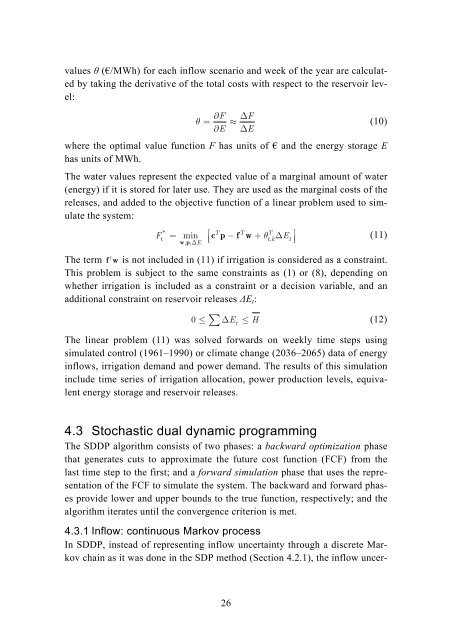A framework for joint management of regional water-energy ... - Orbit
A framework for joint management of regional water-energy ... - Orbit
A framework for joint management of regional water-energy ... - Orbit
Create successful ePaper yourself
Turn your PDF publications into a flip-book with our unique Google optimized e-Paper software.
values θ (€/MWh) <strong>for</strong> each inflow scenario and week <strong>of</strong> the year are calculated<br />
by taking the derivative <strong>of</strong> the total costs with respect to the reservoir level:<br />
F DF<br />
q = »<br />
(10)<br />
E DE<br />
where the optimal value function F has units <strong>of</strong> € and the <strong>energy</strong> storage E<br />
has units <strong>of</strong> MWh.<br />
The <strong>water</strong> values represent the expected value <strong>of</strong> a marginal amount <strong>of</strong> <strong>water</strong><br />
(<strong>energy</strong>) if it is stored <strong>for</strong> later use. They are used as the marginal costs <strong>of</strong> the<br />
releases, and added to the objective function <strong>of</strong> a linear problem used to simulate<br />
the system:<br />
F<br />
é c p f w ù<br />
ú<br />
(11)<br />
û<br />
*<br />
T T T<br />
t<br />
= min - + qt,<br />
kDEt<br />
wp , , DE<br />
êë<br />
The term f T w is not included in (11) if irrigation is considered as a constraint.<br />
This problem is subject to the same constraints as (1) or (8), depending on<br />
whether irrigation is included as a constraint or a decision variable, and an<br />
additional constraint on reservoir releases ΔE t :<br />
£ å D £ H<br />
(12)<br />
0 Et<br />
The linear problem (11) was solved <strong>for</strong>wards on weekly time steps using<br />
simulated control (1961–1990) or climate change (2036–2065) data <strong>of</strong> <strong>energy</strong><br />
inflows, irrigation demand and power demand. The results <strong>of</strong> this simulation<br />
include time series <strong>of</strong> irrigation allocation, power production levels, equivalent<br />
<strong>energy</strong> storage and reservoir releases.<br />
4.3 Stochastic dual dynamic programming<br />
The SDDP algorithm consists <strong>of</strong> two phases: a backward optimization phase<br />
that generates cuts to approximate the future cost function (FCF) from the<br />
last time step to the first; and a <strong>for</strong>ward simulation phase that uses the representation<br />
<strong>of</strong> the FCF to simulate the system. The backward and <strong>for</strong>ward phases<br />
provide lower and upper bounds to the true function, respectively; and the<br />
algorithm iterates until the convergence criterion is met.<br />
4.3.1 Inflow: continuous Markov process<br />
In SDDP, instead <strong>of</strong> representing inflow uncertainty through a discrete Markov<br />
chain as it was done in the SDP method (Section 4.2.1), the inflow uncer-<br />
26
















